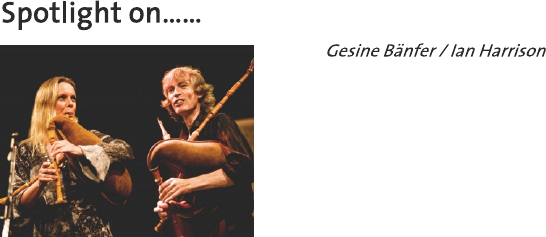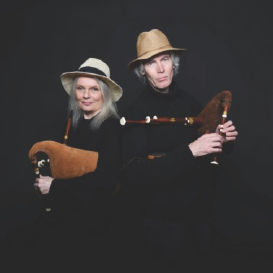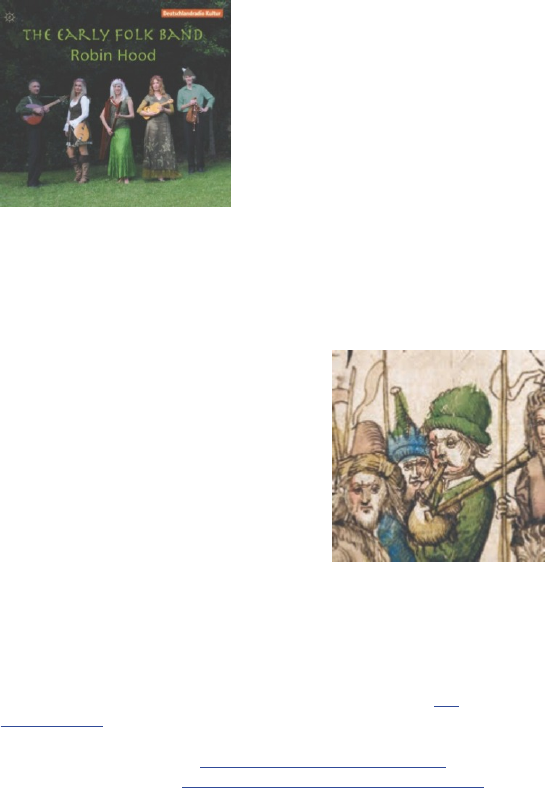The Bagpipe Society
Spotlight on ... Gesine Bänfer and Ian Harrison
Spotlight on … Gesine Bänfer and Ian Harrison

The duo of Gesine Bänfer and Ian Harrison goes back a long way and it has been a winding road full of highs and lows, or as the medieval French would have said, ’Les haulz et les bas‘. Here they talk about their music and their experiences.
Though our musical biographies are very different, both of us became fascinated by ’early’ and ’traditional’ music in our teens. •Gesine learnt music by doing it. •She formed her first group at the age of 14, singing and playing drums, guitar and recorders in the girl folk bandJawbone. Within a year it had morphed into a folk punk band with gigs all around her area and even a television feature about the group. The belief in group dynamic and initiating one’s own musical projects has stayed with her all her life, and she has been the driving force behind countless programmes since.
Ian came from the other side - he was sent kicking and screaming to piano lessons from the age of four and forced by a series of tough teachers to practice arpeggios and Beethoven. He will remain eternally grateful to all of them as they gave him a grounding in music theory and an idea of the meaning of music which has stayed with him all his life.
One boring Sunday morning, Gesine, aged 12, experienced the Great Highland Pipe, suddenly, live, in her small home town of Hofgeismar, near Kassel, Germany when a parade of British soldiers unexpectedly marched down her street. She was bitten. Meanwhile, growing up in Newcastle, Ian was regularly exposed to the bagpipe - meaning the GHP - and on rare occasions even to the Northumbrian Smallpipes - but like many teenagers found them uncool and irrelevant. Both of them came to playing the instrument via early music. Ian started, while living in London, on a ’medieval English’ pipe in G by Alan Ginsberg. In Freiburg, Gesine made herself an EMS pipe in F from a kit and thus was put off for a long time. When we got together in 1991 it was clear we needed to synchronise our pipes.
Of all the instruments available at the time we decided that the best for medieval and renaissance music was the Galician Gaita, and so we ordered sets from the late Anton Varela. In boxwood with horn mounts and an unadorned leather cover both the optical and tonal aesthetics were just right for our needs. Medieval pictures show a bewildering array of different sizes and shapes of pipes but the form with one long drone over the shoulder, one chanter and a sewn swan-neck bag is common in Western European depictions over a wide geographical area and a long period. Also, the bright, loud sound of the Gaita is effective both indoors and outdoors and the wide chromatic range makes it adaptable to many musical genres. We also got Anton to make us two chanters with a low Bb (as opposed to the usual B natural). Ian combines this chanter with the bag and drones from Gesine’s EMS pipe which makes a wonderful ’Flemish’ pipe.
It was with our medieval/renaissance wind bandLes haulz et les bas that our bagpipe duo reached its first audiences•in the early 90’s.•Gesine and Ian play shawms and bagpipes, and our colleagues play slide trumpets, sackbuts,buisines, percussion etc. Les haulz et les bas was born and has grown up in the context of the ’Early Music’ movement whose audiences, critics and concert promoters appreciate not only the virtuosity and the moving power of the music but also its ’authenticity’. This is a vague term and means different things to different people - another buzz phrase is ’historically informed performance practice’. It means that part of the inspiration for playing the music comes from studying sources - contemporary accounts, pictures, manuscripts and early printed editions of the music etc. The sources of the music we play with Les haulz et les bas date from the 13th to the 16th century.
But what about the sources of ’traditional’ or ’folk’ music? It was not until the 2000’s when our interest in this•woke up. It combined our fascination with research into historical sources with our love of folk music and our ability on one of the most important instruments of ’early folk’ music - the bagpipes.
Britain and Ireland in the 17th and 18th centuries produced a vast and rich corpus of manuscripts and prints of ’traditional’ music. This wonderful, magnificent music from the baroque and classical eras was just waiting to be explored. The whole thing took off at the Bagpipe Blowout in 2010 when we heard and saw Mike York playing his ’Border smallpipes’. We ordered two sets that very day. We•formed theEarly Folk Band in 2011 with Gesine on said smallpipes, flageolets (by Jonathan Swayne), cittern, dulcimer and voice and Ian on smallpipes, flageolets, cornett, harp and voice. Gesine commissioned a wonderful copy by Paul Doyle of a cittern made by W. Gibson•(both of Dublin)in 1722. The sound and dynamics of this instrument blend perfectly with the smallpipes. We were immediately offered a co-operation with the biggest German radio station Deutschlandradio Kultur, with whom we have produced two CDs. Our latest CD is a co-production with the South German radio station SWR.

Mike York’s smallpipes are cylindrically-bored and open-ended. They are pitched in 6-finger D at A=440, with a C for the 7th finger and a range up to high D - no keys! The fingering is basically half-closed as in Central French and Border pipes. Two tuning rings enable the player to set high C or C# and B or Bb. Three drones are tuned in D, A and octave D. Gesine plays them mouth-blown and Ian with bellows. The sound is mellow and beautiful, and blends with ’baroque’ string instruments such as cittern, harp, dulcimer, baroque guitar and fiddle - loud enough to be present but not to dominate the sound. The famous picture of ’Northumberland’ piper James Allen (1734-1810) in the frontispiece to his biography by James Thompson (Newcastle-upon-Tyne, 1826) shows him playing exactly this instrument, and there are many other illustrations of similar instruments from that time and earlier. We had found ’our’ instruments for 17th- and 18th-century music from the British isles. For Ian, who grew up in Newcastle, it was like coming home, bagpipe-way. Here was a Northumbrian smallpipe which a punch. And it was the ideal instrument for the music from the book which more than any started this whole thing off:
•William Dixon’s manuscript of 1733, in the edition by Matt Seattle.
As an antidote to authenticity, and living in the Black Forest, far away from any bagpipe tradition, we formedContraband•with German guitarist Thomas Bergmann and Swedish tuba player Jörgen Welander. With this group we experiment with bagpipes and bagpipe tunes from all over Europe with groovy bass lines and jazzy chords. One of our most memorable performances was at the Blowout in 2009. We are flattered that a picture of that concert is still being used on the Society’s web site to publicise future Blowouts. And the following year we experienced another highlight with a duo concert in Polesworth Priory - we still remember the warm and welcoming audience.
Our piping style is of no one school. Like many readers of this journal we were self-taught and have learnt various bagpipes separated by space and time from the cultures which gave rise to them. We were freestylers, free thinkers, unfettered by any traditions, piping cartes blanches, a reboot. We got most of our early education one weekend a year at the University of St. Chartier, sitting at the feet of Macedonian, Galician, Breton, Scottish, French, Irish, English and Italian players, watching and hearing what they did, picking out this ornament, that timing, the other freedom of melody, and hearing in their playing echoes of their medieval forerunners whose performances are captured in countless pictures. Later, books helped. After many decades of trying to ignore the deafening instrument of his northern neighbours Ian finally succumbed and borrowed Gesine’s copy of the School of Piping’s Tutor for the Great Highland Pipe volume one. There was no turning back. Here at last was a method, a school, a plan - and more colours for the palette. The baroque ornamentation and division playing that Ian learnt studying cornett at the Schola Cantorum Basiliensis in Basel, Switzerland has also enriched his playing. He now combines all these things as teacher of shawm and early bagpipes at that institution. The long and winding road continues. For a long time we have been searching, copying styles, interpreting sources, arranging early pieces and gradually we have found our own style - Ian as a soloist accompanied by Gesine on cittern, or as a bagpipe duo.

Ian’s own compositions have enriched our repertoire. Watching late-night Brexit parleys on Parliament Live inspired him to this Brexit Rant: we play it on our website www.early-folk-duo.com. Gesine and Ian’s bagpipe playing can be heard on CD with their ensemblesLes haulz et les bas•and theEarly Folk Band. In 2008 they founded their own independent CD label, Ahalani Records, which shares its profits fairly with its musicians.
Northlands•(2012) is a collection of ballads, songs and dance tunes from Britain and Sweden. Gesine and Ian are joined by the Swedish singer and harp player Miriam Andersén; the German fiddle player Susanne Ansorg**,** and the English baroque guitar player, dancer, actor and comedian Steven Player.
Robin Hood(2014) tells of the famous outlaw in ballads and songs. This CD owes much to the ballad collector Joseph Ritson who, in 1779, walked from his home near Durham to Oxford to “explore the literary treasures of the Bodleian [Library]“, and a few years later walked to Cambridge. He saw “a great many curious books and made a great many important discoveries“. He published his collection of Robin Hood ballads in two volumes in 1795, adorned with engravings by Thomas Bewick. Bewick wrote in his•Memoir: ”I used to engage John Peacock, our inimitable performer, to play on the Northumberland or Small- pipes; and with his old tunes, his lilts, his pauses, and his variations, I was always excessively pleased.“ His son Robert was a pupil of Peacock and himself left a wonderful collection of smallpipe tunes. Both Bewicks lived and worked in Newcastle, Ian’s home town. There are a wealth of pipe tunes on this CD including our version of William Dixon’s Dorrington.

Depiction of a bagpiper at the Council of Constance, Richental Chronicle, fol 76l, second half of the 15th century
Lumps of Puddingis our latest recording - a live Winter CD of a performance in December 2018 in Freiburg, Germany, with all the associated energy and spontaneity: mumming, carols, winter ballads, a stick dance and instrumental music ranging from Vivaldi to Pepusch to the Fitzwilliam Virginal Book to the Hannay-McAuslan ms. of c.1815. It is available now but will be reviewed in a future edition of Chanter.
In its 25th anniversary year the ensembleLes haulz et les basmarked the 600th anniversary of the Council of Constance with a programme of music for the alta capella ensembles. The Council, (1414-1418) gathered together Europe’s political and religious elite, together with singers and musicians playing trumpets, bagpipes and shawms. This recording marks this event. Finally, in our recording, ars supernova, Les haulz et les bas celebrates seven centuries of wind bands and the exchange of material between early music and jazz. (A review of this CD was printed in Chanter, Autumn 2018) We prove that the saxophone is the ideal instrument for the 14th-century ars nova and that the medieval shawms and bagpipes have just the sound that jazz has been waiting for! The greatest hit on this CD is Ian’s composition “Aires de Bollschweil“ for two gaitas, trombone, tuba, soprano saxophone, guitar and•percussion - you can see a live version of this on our website ars- supernova.com. This is our four daughters’ favourite track!
If you would like to find out more about our groups, concert diaries and programmes then please visit www.office-of-musicians-affairs.com. We also have a new Facebook page www.facebook.com/gesinebanfer.ianharrison.
- Data Processing Notice (GDPR)
-
@BagpipeSociety on X (formally known as Twitter)
-
TheBagpipeSociety on Instagram
-
 BagpipeSociety on Facebook
BagpipeSociety on Facebook
Something wrong or missing from this page? Let us know!
